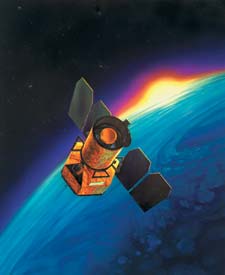
The Galaxy Evolution Explorer (GALEX) launched successfuly aboard a Pegasus rocket on April 28, 2003.
Courtesy Karl Forster (Caltech).
Astronomers have never been so excited about getting a sunburn. At 8 a.m. EDT today, a Pegasus rocket hoisted NASA's Galaxy Evolution Explorer into orbit 690 kilometers above the Earth. The 280-kilogram satellite, also known as GALEX, will be the first space-bound telescope to make a thorough ultraviolet map of the universe. During its 29-month-long mission, it will survey 10 billion years of galactic evolution in UV light.
"This mission will provide the first comprehensive map of a universe of galaxies under construction and bring us closer to understanding how they were built," says Christopher Martin (Caltech), GALEX's principal investigator.
Armed with the first large space-based far- and near-UV detectors, GALEX is poised to determine how today's millions of galaxies came to be.
Young stars typically emit powerful UV signals, so observations in ultraviolet light are crucial toward understanding the origins of galaxies. Previous space missions have suggested that a stellar "baby boom" occurred 5 to 8 billion years ago, and that UV output is proportional to the rate at which these stars formed.
While the Hubble Space Telescope, the Far Ultraviolet Spectroscopic Explorer (FUSE), and the Extreme Ultraviolet Explorer (EUVE) have all conducted detailed UV studies of a few thousand celestial objects, GALEX will perform a large "demographic" survey of tens of millions of galaxies. The 50-centimeter telescope's wide field of view will span 1.2° — more than twice the angular diameter of the Moon. In comparison, Hubble has a field of view some 1/30th that of GALEX.
In addition to gathering images, GALEX will also take spectral surveys with a "grism" (a spectrometer grating on a prism), which will split light and tell cosmologists the rate of star formation, distance, and the gas and dust content of more than 100,000 galaxies.
"I am excited and hopeful," said Martin of the launch. "I know that all sorts of things could happen, but we must take risks in order to explore new territory of any kind. We are mapping the universe in a new band of the spectrum, and we can hope to discover new objects that we do not expect."
Initial indications show that all systems are in working order after this morning's launch. GALEX's solar panels successfully deployed and the craft is in a stable Earth orbit. It will go through a month of testing before beginning its mission in June.
 0
0
Comments
You must be logged in to post a comment.